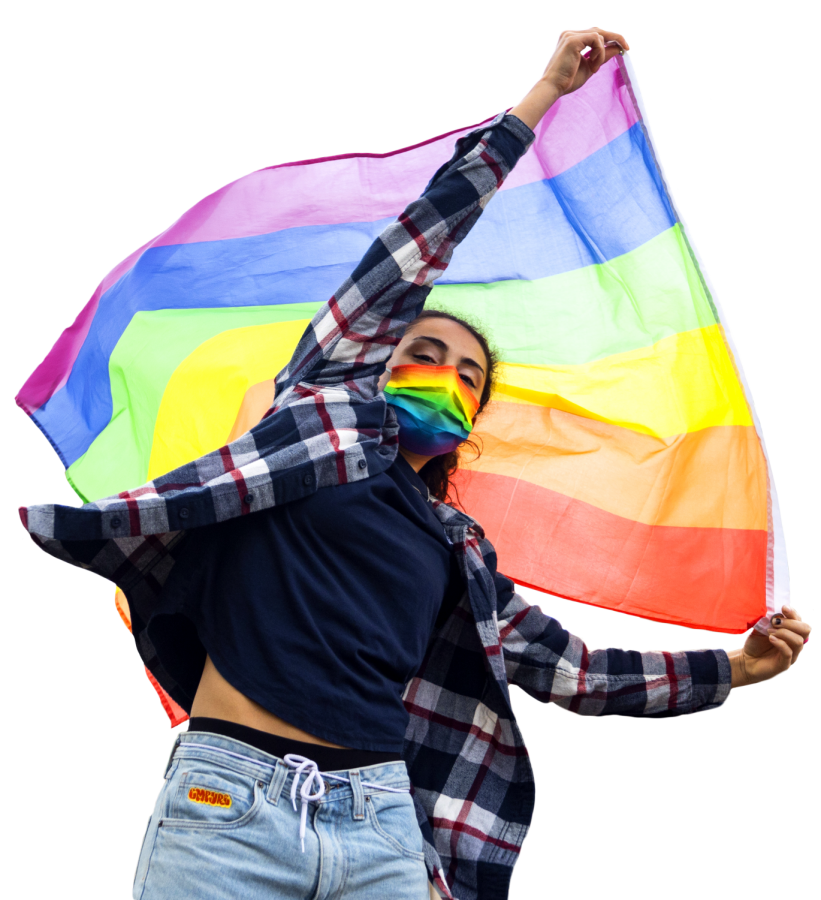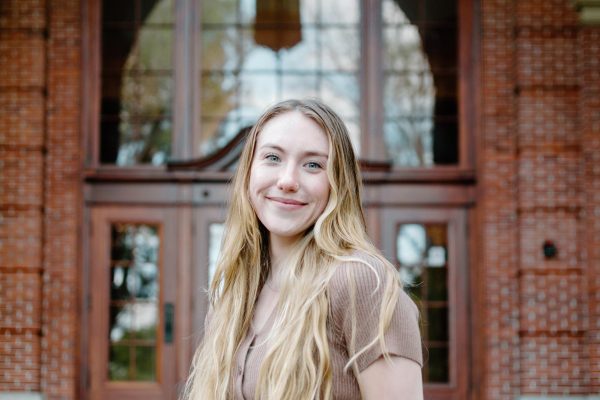‘An ever-evolving mission’: Pride Center celebrates 20 years on campus
First-year mathematics student Ana Bacon (she/her) waves the Pride flag in front of the Memorial Union on Nov. 14. The Pride Center on Oregon State University’s Corvallis, Ore. campus is celebrating its 20th anniversary this year and was first established in May 2001.
November 29, 2021
The Oregon State University Pride Center celebrates 20 years as an on-campus home for queer-identifying students thanks to continuous student-driven work.
“Twenty years of being a cultural resource center means that generations of students, long before the center itself existed, right up to the present, organized and advocated and petitioned,” said Cindy Konrad, the Pride Center director.
The need for a Pride Center became apparent in 1998 as homophobia and transphobia ran rampant throughout campus, according to Ellen Dishman, a student at the time who was key in starting the center.
Even prior to the center’s creation, queer spaces and support were solely student run.
These initiatives are in great connnection with the Rainbow Continuum, an active club on campus that makes safe spaces for queer people and works to educate allies.
Dishman was involved with the Rainbow Continuum in 1999.
“We were a very, very active organization… We also had an office in Student Involvement; we were the only student group who had an office because we were basically running a mini cultural center out of the office,” Dishman said.
Student Involvement was a department now known as Student Experiences and Engagement at OSU. LGBTQIA2S+ students and allies rallied together in 1999 to create the first foundations of what would become the Pride Center, housed within the Hattie Redmond Women and Gender Center, then named the Queer Resource Center.
LGBTQIA2S+ is an acronym that generally stands for lesbian, gay, bisexual, transgender, queer or questioning, intersex, asexual and two-spirit identities, with the plus sign signifying the acronym is incomplete.
Dishman’s time as an undergraduate on campus was spent bringing awareness, advocating and fundraising for the community. Her work continued past her own time at the university thanks to the continuous efforts of students to bring the center to life.
According to Konrad, the Student Fee Committee voted unanimously in 2001 to approve a budget for the Queer Resource Fair. The fair raised awareness and funds for the center to open as its own independent space in 2004 and be renamed the Pride Center as we know it today.
“They struggled and fought to create a more affirming and celebratory experience on campus, for the ability to be their authentic selves,” Konrad said. “Student leaders have provided care for each other, created programs and accepting spaces. The center, and so many of the positive changes on campus, are these students’ legacy.”
Dishman and Konrad credit not only the center’s creation, but the continuous success and evolution of the center to the fact that programming and initiatives are student run.
“One of the most amazing things about having a student-initiated and student-run center like the Pride Center is that students are the ones that are pursuing what matters to them,” Dishman said.
Marin Monty, a third-year student leader in the Pride Center, said they are extremely grateful for the ways the center has expanded to reach more groups in need of support and a home on campus.
SOL, a multicultural queer support resource housed in the Pride Center, is one example of expansions born out of student need and interest.
“I am eternally grateful for SOL, which acts everyday to carve out a space for [Queer, Transgender, Black, Indigenous, and People of Color] that has not existed—and, in many places, still does not exist—but is so incredibly important,” Monty said. “The staff at Pride and SOL helped me find my way through the world of advocacy as well as navigating being Queer in STEM, which is still an incredibly cisnormative place.”
The center’s work has extended beyond just providing spaces for students already on campus. For first-year math student Ana Bacon, just knowing there was a supported resource on campus is a part of the reason she came to OSU as a whole.
“It’s really meaningful they offer a vision and make sure everybody feels seen and heard, even if you don’t go to the Pride Center just being able to know that the resource is there for people is a really big deal,” Bacon said.
As the center looks back at celebrating 20 years, the community also looks forward to the future of the Pride Center.
In addition to a new building in the works, Konrad said the center’s future has unlimited potential to support those vulnerable members of the community to ensure they feel safe and welcomed.
“It is never irrelevant; it never works through its purpose; it never becomes outdated or obsolete because the students are working on what needs to be worked on next,” Dishman said. “It’s sort of an ever-evolving mission, and I think that is beautiful.”
The center hopes to gather together past and present community members to celebrate the anniversary later in the school year, likely in the spring, as the center reflects on its legacy.
Konrad also said the future will find the Pride Center in a renovated building that will better fit the community’s size and needs.
“We’re currently working with Campus Planning and an architectural firm on plans for a renovation that is scheduled to begin in summer 2022 and will provide campus with a Pride Center that is homey, comfortable, welcoming and much more accessible,” Konrad said.











































































































